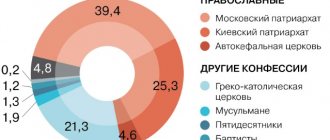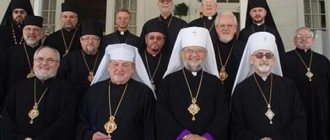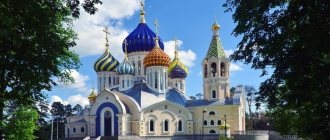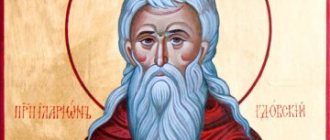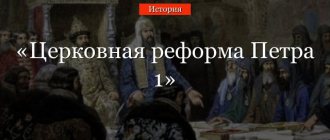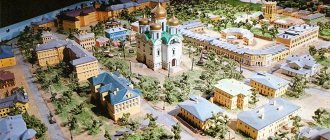| Finnish Orthodox Church (Archdiocese of Finland) | |
| Finnish Suomen ortodoksinen kirkko swed. Orthodoxa kyrkan i Finland | |
| Assumption Cathedral | |
| General information | |
| Founders | Tikhon |
| Base | 1921 |
| Confession | Orthodox Church |
| Mother Church | Moscow Patriarchate |
| Autonomy | February 11, 1921 |
| Recognition of autonomy | 1923 (confirmed by the Moscow Patriarchate in 1957) |
| Management | |
| Primate | Archbishop Leo (Makkonen) |
| Center | Helsinki, Finland[1] |
| Territories | |
| Jurisdiction (territory) | Finland |
| Dioceses outside jurisdiction | No |
| Divine service | |
| Liturgical language | Finnish (rarely Swedish, Church Slavonic) |
| Calendar | Gregorian |
| Statistics | |
| Bishops | 3 (+2 at rest) |
| Dioceses | 3 |
| Educational institutions | 1 |
| Monasteries | 2 and 1 private |
| Parishes | 12 parish-deanery |
| Monks and nuns | 20 |
| Website | ort.fi(in Finnish) ort.fi/ru/(in Russian) |
| Media files on Wikimedia Commons | |
| Information on Wikidata? | |
Finnish Orthodox Church
(Finnish: Suomen ortodoksinen kirkko, Swedish: Finska ortodoxa kyrkan, other names:
Orthodox
Church of Finland, Finnish: Ortodoksinen kirkko Suomessa, Swedish: Ortodoxa kyrkan i Finland, Greek: Ορθόδο ξη Εκκλησία της Φιλλανδίας,
Finnish Archdiocese of the Patriarchate of Constantinople
, Greek. Ορθόδοξος Αρχιεπισκοπή Φινλανδίας) is an autonomous Orthodox Church.
From 1921 to 1923 it was under the jurisdiction of the Moscow Patriarchate, since 1923 - under the jurisdiction of the Constantinople Patriarchate.
Content
- 1 Church history 1.1 Old Calendar movement in Finland
- 3.1 Diocese within the Russian Orthodox Church (1892-1918)
Statistics
- beginning of the 19th century in “Russian Finland”, before the annexation of “Swedish” [4] - 19 churches and 27,454 parishioners (mostly military personnel of Russian garrisons)
- 1838 [4] - 21 churches, 36,000 parishioners (of which: about 98% in the Vyborg and Kuopio provinces, in Neishlot 156, in Helsingfors 256)
- OK. 1863 [4] - 45,227 Orthodox (3% of the 1.5 million inhabitants of Finland)
- on the eve of the “winter war” 1939-1940 [4] - 46 priests, 80,000 believers
- 1940 - 81,631 people [3]
- 1990 - 55,924 people [3]
- mid-2000s [2] - Approx. 60,000 registered parishioners (approx. 1.1% of the Finnish population), 24 parishes, 2 monasteries
- end 2013 - 61,218 people [3]
Church history
The first Orthodox Christians in Finland were baptized Karelians (their descendants still make up the majority of the Finnish Church). The annexation of Finland to Russia in 1809 gave a great impetus to the development of Orthodoxy. The divine service, as well as many spiritual works, were translated into Finnish. In 1892, the Finnish-Vyborg diocese was formed.
Until 1918, the Finnish-Vyborg Diocese in the Grand Duchy of Finland was part of the Russian Orthodox Church (ROC). After Finland gained independence in 1917, the Extraordinary Council of Clergy and Laity of the Finnish-Vyborg Diocese in 1919 adopted an appeal to His Holiness Patriarch of Moscow and All Russia Tikhon (Bellavin) to grant the diocese the status of an autonomous church within the Russian Orthodox Church, which was recognized by the Patriarch on February 11, 1921 . In 1918, the property of the Russian Orthodox Church in Finland was nationalized and transferred to the newly established Finnish Autonomous Church.
Under pressure from the Finnish government, which demanded complete independence of the Finnish Church from the Moscow Patriarchate, a church-governmental delegation consisting of Archpriest Herman Aav, Archpriest Sergius Solntsev and Government representative Professor Emil Setal was in Constantinople from July 2 to 13, 1923 and addressed the Patriarchate of Constantinople with a request about autocephaly, despite the protests of both the Moscow Patriarchate and the Finnish and Vyborg Archbishop Seraphim (Lukyanov) of the Russian Church Abroad[2]. On July 6, 1923, a tomos followed to grant autonomy to the Finnish Orthodox Church under the jurisdiction of the Patriarchate of Constantinople. At the same time, Patriarch Meletios (Metaxakis) emphasized the untimeliness of granting autocephaly to the Finnish Church and confirmed the temporary nature of its acceptance into the Patriarchate of Constantinople until the normalization of church life in Russia[2]. On July 8 of the same year, Patriarch Meletius performed the episcopal consecration of the Estonian Archpriest Herman Aav (Orthodox Russian Church), who was consecrated as suffragan bishop of Karelian. On November 13-20, 1923, the Extraordinary Council of the Finnish Church in Serdobol, chaired by Archbishop Seraphim (Lukyanov) of Vyborg and All Finland, unanimously accepted the transition to the jurisdiction of the Patriarchate of Constantinople, which decision was endowed with the force of law by the government of Finland. The Gregorian calendar and the Finnish language in worship were introduced; The parishes were divided into two dioceses: Vyborg and Karelian. The archbishop's chair remained in Vyborg.
Based on paragraph 3 of the Decree of the President of Finland Karl Stolberg dated December 29, 1923, Archbishop of Vyborg and All Finland Seraphim (Lukyanov) was removed from the administration of the Church from January 1, 1924 due to his non-compliance with the requirements of the law on the official language. The place of his residence was determined to be the Konevsky Monastery. Bishop Herman of Karelia (Aav) was appointed to serve as archbishop. The decree sent to the Finnish church administration by Patriarch Tikhon on November 28, 1923 (No. 186), which ordered “to find out, in communication with the government of the Finnish Republic, the possibility of returning church affairs in Finland to their previously occupied position” [3], was left by the government without consequences .
Transfiguration Church of the New Valaam Monastery
After the Soviet-Finnish War of 1939-1940 and the annexation of part of Karelia to the Soviet Union, the Finnish Church lost about 90% of its property, and most of the believers were evacuated to the interior of Finland. For example, the entire monks from the Valaam Monastery were evacuated from the archipelago and founded the New Valaam Monastery in central Finland (near Heinävesi). The theological seminary (founded in 1918) in the city of Sortavala (Serdobol) was also moved to Helsinki (in 1957 it moved to Humalarvi, in 1961 to Kuopio, and in 1988 it was closed, and in its place the Faculty of Orthodox Theology was opened at the University of Joensuu). Based on Heli Kananen's research, it is argued that Orthodox Christians resettled from Karelia were subject to discrimination in Finland.[4]
Church of the Resurrection in Jyväskylä
At the beginning of October 1945, negotiations with the aim of returning the Finnish Church to the jurisdiction of the Moscow Patriarchate were conducted by Metropolitan Gregory (Chukov) of Leningrad, on which a preliminary agreement was reached with Archbishop Herman of Karelian (Aav) on October 3 (to make a decision on reunification, a Council of the Federal Orthodox Church was envisaged). After correspondence with Moscow that followed for a number of years, on April 30, 1957, the Synod of the Russian Orthodox Church decided to “consign to oblivion all canonical disputes and misunderstandings that took place between the FOC and the Russian Orthodox Church,” recognized the Archdiocese of Finland in its existing status and transferred the New Valaam Archdiocese to its jurisdiction monastery; On May 7 of the same year, the parties restored prayerful and canonical communication[5].
In 1980, the Finnish Autonomous Church asked the Patriarchate of Constantinople to grant the Church autocephalous status, but there was no response.
Old Calendar movement in Finland
Main article: Patriarchal parishes in Finland
As a reaction to the introduction of a new style, Western Paschal, in the Finnish Orthodox Church in the 1920s, a change in hierarchical power (the exile of Archbishop Seraphim (Lukyanov) to the Konevetsky Monastery) and the transition to the jurisdiction of Constantinople, without the consent of Patriarch Tikhon, as well as the dominant territory of Finland of phyletism, several private Orthodox communities arose in the country, which later entered the fold of the Russian Orthodox Church (from 1926 to 1945 they recognized the jurisdiction of Metropolitan Eulogius (Georgievsky) and at the same time the Synod of the ROCOR, in 1945 these parishes were accepted by the Moscow Patriarchate). The Old Calendarist movement was especially strong in the Valaam and Lintul monasteries.
St. Nicholas Church of the Moscow Patriarchate in Helsinki
In 1926, the Intercession community in Vyborg was registered in the state register of Finland on the basis of a new law on freedom of religion (after 1939 the parish and church were moved to Helsinki).
In May 1927, the Nikolskaya Community was registered in Helsinki. In 1945, the Finnish deanery of the Moscow Patriarchate was formed on the territory of Finland, which included: the brethren of the Valaam Monastery evacuated from the archipelago deep into Finland, the Intercession and St. Nicholas communities in Helsinki. Pokrovsky and St. Nicholas parishes (often referred to simply as “Old Calendar”) are currently experiencing significant growth due to emigrants from the countries of the former CIS, as well as educational activities. The total number of registered parishioners of Old Calendar parishes is approaching 3 thousand (in Nikolskaya - about 2 thousand; in Pokrovskaya - about 700 people), but the total number of believers who adhere to the Julian calendar significantly exceeds official data, since according to Finnish legislation only those permanently residing in countries can register their religious affiliation.
In 1999, a parish was opened in honor of the Kazan Icon of the Mother of God in Pori.
In 2001, the Assumption Parish in Turku began to operate.
In 2003, a parish was registered in honor of Rev. Seraphim of Sarov in the village of Stormi, near Vammala (60 km from Tampere).
In 2008, a parish was founded in Lahti.
Religion of children
The decision about a child’s religious choice is made by his parents. If there is no agreement between the parents on the choice of religion for the child, the child will not be assigned to any religious community. If, by court decision, one of the parents is the sole guardian of the child, he or she can alone decide on the child’s religious affiliation.
The child has the right to study his religion at school. More information can be found on the InfoFinland website under Basic general education.
A child who has turned 18 years old is an adult and independently chooses his or her religion.
Structure and current state
Lintula Convent and Assumption Cathedral in Helsinki (1862-1868).
Orthodox cemetery in Helsinki Church in Tapiola Espoo (1998) Primate with the title Archbishop of Helsinki and Finland
is Leo (Makkonen).
As of 2005, the total number of registered members was 57,756 (1.1% of the population), and the archdiocese, along with the Evangelical Lutheran Church of Finland, has the status of one of two state denominations.
Divided into three dioceses:
- Karelian (Finnish: Karjalan hiippakunta) Joensuu Vicariate
Since 1955, the bishop of the Karelian diocese has been the archbishop (primate) of the entire autonomous church, but in May 2012 the question of moving the archiepiscopal see to Helsinki was raised[6]. On October 10, 2021, the Board of the Church Administration approved the submission of the issue of transferring the archbishop's see from Kuopio to Helsinki for consideration by the delegates of the Local Council, which will take place on November 27-29, 2021[7].
Diocesan bishops bear the title of metropolitans. The vicar of the Karelian Archdiocese has the title of Bishop of Joensuu.
The total number of parishes is 24. There are the New Valaam and Lintul monasteries, as well as the private Intercession Brotherhood. The Church Administration in Kuopio operates a museum of ecclesiastical art. The Church uses the new (Gregorian) calendar and Western Easter. A number of innovations are present in liturgical practice, icon painting[8] and canonical structure.
The highest legislative authority in the church is the local and bishops' councils. The executive branch responsible for implementing decisions is the Church Administration. Income is subsidized by the state using tax funds (contributions from registered members amount to 0.6% of income and are automatically deducted from the bank account).
Orthodox theology for candidates for clergy is taught at the Faculty of Theology of the University of Joensuu, and a theological seminary operates to train psalmists and choir directors. There are organizations of Orthodox youth that organize annual camps and conventions[9].
In accordance with Finnish legislation, city cemeteries provide Orthodox burial plots for members of Finnish Orthodox parishes. The most famous is the memorial Orthodox necropolis in the center of Helsinki.
On June 15, 2021, the Council of Bishops of the FOC drew up a proposal on the possible restructuring of the dioceses of the FOC. The Council of Bishops considered it necessary to maintain the boundaries of the existing dioceses without changes, with one exception: the transfer of the Orthodox parish of Tampere to the Diocese of Oulu[10].
Main liturgical languages: Finnish, Russian, Church Slavonic[11].
Gods
Like any paganism, the ancient religion of Finland assumed polytheism. The gods controlled the elements - thunder, storms, winds. Ukko dominated the Finnish pantheon. He was considered the ruler of the sky and thunder. It is noteworthy that the ancient Finns believed in the trinity of the soul. Its elements were independent of each other. "Henki" was life. She entered the body even before the birth of the baby, with the first push in the womb of the mother. And she left the man’s henki with her last breath.
“Luonto” is a person’s genius, his talent, his gifts. And finally, “itse” is a person’s self-awareness. The last two elements could leave a person’s body without him dying. But their long absence affected their well-being. Without luonto, a person became addicted to bad habits, became weak-willed, and without it, he suffered from depression. The magicians who performed magical rituals could help return these two elements. These same shamans were “conductors” between the worlds of living and deceased ancestors.
Territorial administrative structure
The Grand Duchy of Finland is the territory of the Vyborg-Finland Diocese of the Diocese and parishes of the Orthodox Church of Finland.
Diocese within the Russian Orthodox Church (1892-1918)
Vyborg and Finnish Diocese
:
- Anthony (Vadkovsky) (October 24, 1892 - December 25, 1898)
- Nikolai (Nalimov) (January 16, 1899 - April 8, 1905)
- Sergius (Stragorodsky) (October 6, 1905 - August 10, 1917)
- Seraphim (Lukyanov) (August 11, 1917-1923) (until January 17, 1918), since 1921 head of the autonomous church within the Moscow Patriarchate;
Serdobol Vicariate
Vyborg diocese
- Cyprian (Shnitnikov) (March 10, 1913 - June 18, 1914)
- Seraphim (Lukyanov) (September 7, 1914 - January 17, 1918)
In 1921, the Vyborg and Finnish diocese was transformed into the Finnish Autonomous Orthodox Church within the Moscow Patriarchate. In 1923, bypassing the canonical order, the Finnish Autonomous Orthodox Church subordinated itself to the Patriarchate of Constantinople, which granted it autonomy for the second time under the name Finnish Archdiocese
.
Finnish Archdiocese of the KP (since 1923)
Archbishops (they are also the administrators of the Karelian diocese)
- Hermann (Aav) (July 8, 1923 - July 1, 1960)
- Pavel (Gusev-Olmari) (1960—1987)
- John (Rinne) (1987—2001)
- Lev (Makkonen) (October 25, 2001 – November 29, 2018)
- Arseniy (Heikkinen)
(from November 29, 2018)
Joensuu Vicariate of the Karelian Diocese
- Pavel (Gusev-Olmari) (October 27, 1955—August 29, 1960)
- Lev (Makkonen) (1 March 1979–1980)
- Alexy (Rantala) (March 2, 1980—January 22, 1984)
- Tikhon (Tayakka) (1984-1988)
- Ambrose (Jaaskeläinen) (March 20, 1988—1996)
- Panteleimon (Sarkho) (March 16, 1997—2001)
- Arseny (Heikkinen) (2005—2018)
Diocese of Helsinki
- Alexander (Karpin) (1940—1969)
- John (Rinne) (1972-1987) (1970-1972 - temporary manager)
- Tikhon (Tayakka) (1988-1996)
- Lev (Makkonen) (1996-2001)
- Panteleimon (Sarkho)
(2001-2002) v/u - Ambrose (Jaaskeläinen) (2002—2018)
- Lev (Makkonen)
(since 2018)
Oulu Diocese
- Lev (Makkonen) (1980-1996)
- Ambrose (Jaaskeläinen) (1996—2002)
- Panteleimon (Sarkho) (2002—2013)
- Arseniy (Heikkinen)
(2013-2014) supreme bishop of Joensuu - Ilia (Walgren) (since 2015)
Interesting facts about religion in Finland
The most interesting fact is that the country, being essentially a secular state, proclaims the principle of state religions.
Finland was one of the last to accept Christianity in Western Europe.
To this day, pagan remnants are very characteristic of the Finnish hinterland. Same-sex marriage has been legal in the country since 2002. This measure is approved by the main denomination of the country - Lutherans.
Read on our website: in which countries religion was banned.
Number
The dynamics of the number of Orthodox Christians in Finland shows the approximate stability of believers of this denomination in recent years, ranging from 0.8% (1988) to 1.1% (2005) of the country’s total population.
| Year | Karelian Archdiocese | Metropolitanate of Helsingfors | Oulu Metropolitanate | Population of the country | Number of Orthodox | V % | Note |
| 1988 | 23 737 | 24 301 | 7 356 | 56 231 | 0,85 % | ||
| 1989 | 23 656 | 24 367 | 7 266 | 56 123 | 0,88 % | ||
| 1995 | 23 081 | 26 372 | 7 216 | 57 257 | |||
| 1997 | 22 845 | 27 189 | 7 053 | 57 625 | |||
| 1998 | 22 742 | 27 778 | 7 028 | 5 160 000 | 58 084 | 1,1 % | |
| 2001 | 21 539 | 28 170 | 6 540 | 5 194 901 | 56 269 | 1,08 % | |
| 2002 | 21 470 | 28 801 | 6 468 | 5 199 900 | 56 761 | 1,09 % | |
| 2005 | 21 162 | 30 053 | 6 521 | 5 246 879 | 57 756 | 1,1 % |
At the end of 2015, the number of Muslims in Finland exceeded the number of Orthodox Christians and placed the Muslim community in second place in terms of the number of followers after the Evangelical Lutheran Church[12][13].
Traditional beliefs of the Finns
Ancient cults are beautifully described in the national epic “Kalevala”. Like other peoples of Northern Europe, the Finns remained pagans for a long time. The harsh climate contributed to the fact that people who did not know the origin of certain natural phenomena began to deify the elements. After all, for a long time the survival of an entire tribe depended on the migrations of reindeer and the catch of fish.
The first religion of Finland suggested the origin of the world from the egg of a mythical bird. It fell into the water and earth was formed. The axis of the world stretches between the center of the egg and the North Star. When the sky rotates along it, the Kinakhmi whirlpool is formed, which means “navel of the sea.” Through this tunnel, the souls of the dead, as the ancient Finns believed, were transported to the afterlife kingdom of Tuonelu. Life there was similar to earthly life. Therefore, tools, belongings and decorations were placed in the grave of the deceased.
Notes
- Local Council of the Federal Orthodox Church: The Primate See is transferred to Helsinki. – Finnish Orthodox Church
- ↑ 1 2 V. V. T.
German // Orthodox Encyclopedia. - M.: Church and Scientific, 2006. - T. XI: “George - Gomar.” — pp. 237-239. — 752 p. — 39,000 copies. — ISBN 5-89572-017-X. - Quote by: A. Buevsky.
Patriarch Meletius IV of Constantinople and the Russian Orthodox Church. // ZhMP. 1953, No. 3, p. 35. - Orthodox Christians evacuated from Karelia were subjected to poor treatment (unspecified)
.
yle.fi.
_ Yle News Service (November 27, 2010). Access date: November 28, 2012. - JMP. 1957, No. 6. - P. 17-20.
- The Archdiocese of the Orthodox Church of Finland will be moved from Kuopio to Helsinki (unspecified)
.
yle.fi.
_ Yle News Service (2012-5-30). Access date: May 30, 2012. - On the possible transfer of the archiepiscopal see of the Finnish Orthodox Church from Kuopio to Helsinki (unspecified)
. Access date: October 30, 2021. - A Lego icon is also an icon. (undefined)
.
yle.fi.
_ Yle News Service (2015-9-2). Date accessed: September 6, 2015. - Orthodox youth will gather in the mine (unspecified)
.
yle.fi.
_ Yle News Service (2013-9-19). Access date: September 22, 2013. - Orthodox parish of Tamepere - part of the Diocese of Oulu - Finnish Orthodox Church
- Finland through the eyes of a Russian pilgrim (undefined)
. Date accessed: August 3, 2021. - Muslims have become the second largest religious group in Finland. (undefined)
.
yle.fi.
_ Yle News Service (November 12, 2015). Access date: November 12, 2015. - The boundaries between religion and worldview are blurred - some leave the church, others regain their faith. (undefined)
.
yle.fi.
_ Yle News Service (2016-7-1). Date accessed: July 6, 2016. - Finland received its first saints - they were the martyr John of Ilomantsi and the Monk John of Valaam (unspecified)
. Website of the television and radio company Yleisradio Oy. Yle News Service (April 19, 2019). Date accessed: April 20, 2021. Archived April 20, 2021.
Lutheranism: difference from Orthodoxy
Both of these religions are Christian, believe in one God and revere Jesus as the messiah and the Holy Spirit as the bestower of grace. However, Lutheranism places Scripture at the forefront - the Bible, Gospel, etc. In Orthodoxy, church tradition is revered first of all. The Catholic and Orthodox churches attach great importance to the cult of saints, icons, and holy places.
The branch of Protestantism, Lutheranism, in contrast to Orthodoxy, believes that Christ is the only mediator and intercessor of people before God. Paintings on religious themes are not shrines, but illustrations of the text of scriptures. Neither prayers to saints, nor veneration of relics and bones make sense. Funeral services also give nothing to the dead - after all, you cannot force God to change the decision about their afterlife fate by lighting candles and chanting. But nevertheless, Lutheranism and Orthodoxy have common points. Both religions honor baptism and communion as sacraments.
Literature
- Koukkunen Heikki
. Tuiskua ja tyventa: Suomen ortodoksinen kirkko 1918—1978. Valamon luostari. Heinavesi, 1982. - 205 s. - Purmonen Veikko
Orthodoxy in Finland. Past and present. - Kuopio, 1984. - ISBN 951-95582-2-5 - Kurkimies I. N.
Orthodox churches in Finland // Nevsky Archive: Collection of Historical and Local Lore. Vol. 5. - St. Petersburg: Faces of Russia, 2001. - P. 472-507. - Hieromonk Silouan (Nikitin).
Finland in the 20th century: politics and the Church. Website of the Department of Church History of the Moscow Academy of Sciences, 03/16/2015. - Hieromonk Silouan (Nikitin).
Project for granting autocephaly to the Finnish Orthodox Church in the 50s.
XX century (undefined)
.
bogoslov.ru
(2015-5-8). - Shevchenko T.I.
On the issue of the jurisdiction of the Finnish Orthodox Church // Bulletin of PSTGU II: History. History of the Russian Orthodox Church. 2008. - Issue. II:1 (26). — P. 42—69 - Shevchenko T.I.
Canonical recognition of the Finnish Orthodox Church by the Moscow Patriarchate in 1957 // New and recent history. - 2010. - No. 1. - P. 156-166. - Shevchenko T. I.
Valaam Monastery and the formation of the Finnish Orthodox Church (1917-1957). - Moscow: PSTGU Publishing House, 2013. - 500 p. — ISBN 978-5-7429-0667-4 - Shevchenko T.I.
On the problem of the gap in canonical communication between the Russian and Finnish Orthodox Churches // Bulletin of PSTGU. Episode 2: History. History of the Russian Orthodox Church. — 2015. — Issue. 3 (64). — P. 61-76. - Shkarovsky M.V.
Constantinople and Russian churches during the period of great upheavals (1910s - 1950s). - M.: Publishing house. house "Cognition", 2021. - 304 p. — ISBN 978-5-906960-59-7.
Activities of religious communities
The Lutheran Church of Finland actively promotes its religion in the form of missionary activities; its representatives actively preach Christianity in underdeveloped countries of Asia and Africa.
The Christian Union party is the only religious group that takes part in presidential and parliamentary elections, although it cannot be called numerous.
The entire world community was surprised by the results of the elections in 200, in which a woman representative of the left, known for her extremely negative attitude towards the church, won. With each new population census, the number of atheists in the country grows, and the church loses its influence.

